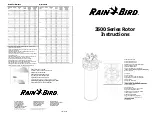
NI DIDS-2100 Series User Manual | © National Instruments | 109
4.6 Engine Position Tracking Setup Window
The purpose of the Engine Position Tracking (EPT) Setup window is to configure angular position tracking of the
engine crankshaft for supervising the generation of engine-synchronous injection commands. The
window contains a tabbed pane with four tabs:
: Tab for configuring parameters related to the EPT functions
: Tab for assigning Top Dead Center (TDC) values to each DI Driver and PFI Driver channel.
: Tab for configuring the crank angle capture of rising edges of Cam1 and Cam2 signals.
: Tab for diagnosing problems with engine position tracking and signals.
Configuration of EPT is only applicable if one or more of the DI Driver modules or PFI Driver module is configured for
EPT mode
. EPT supports a variety of crank and cam signal patterns, including encoder patterns, N-M patterns and
N+1 patterns.
Position Signal Types and Connections
The DI Driver System supports digital crank and cam position signal types wired to the NI 9411 digital input module
or the NI 9760 VR/Hall input module. Hall-effect sensors are a common example of digital position sensors. They are
active sensors requiring power and ground. There are a wide variety of Hall-effect position sensors and they typically
have three wires. Some drive their outputs digitally low and high from 0 V (signal ground) to the sensor power supply
voltage, resulting in a square-wave pulse as a trigger tooth passes the sensor. The NI 9411 will accept a digital high
voltage level up to 24V, and the NI 9760 will accept digital high voltage up to 60V. Other types of Hall-effect sensors
have an open-collector or open-drain output which requires a pullup resistor (typically ~5 KOhm) connected between
the sensor output and the sensor power supply voltage. The pullup resistor should be installed as physically close
to the NI 9411 module as possible. The sensor data sheet should be consulted for properly connecting the sensor to
power, ground, and the NI 9411 digital input channel.
The NI 9411 supports both single-ended and differential digital signal types. Hall-effect sensors typically have single-
ended outputs and should be wired to the “a” input pin of its associated digital input channel, while leaving the “b” pin
disconnected, or floating. This configuration causes a default 1.5V threshold for detecting a low (FALSE or 0) or high
(TRUE or 1) digital input. If the sensor requires a different switching threshold, then a voltage other than 1.5 V can
be wired to the “b” pin. This can be accomplished by a simple resistor voltage divider close to the module.
Sometimes, optical encoders have a differential, or complementary pair of outputs for each signal. In this case, the
differential pair should be connected to the “a” and “b” pins of the NI 9411 input channel.
In all cases, the sensor ground should be connected to the NI 9411 COM pin as a voltage reference, otherwise the
module will not be able to read the proper digital signal level. Refer to the
operating manual for the NI 9411
module
for further details.
The NI 9760 supports two different types sensors, variable reluctance (VR) and general purpose digital sensors, and
requires different wiring for the different sensor types. VR position sensors are passive sensors and are sometimes
referred to as inductive or magnetic (“mag”) pickup sensors. They typically have only two wires. These sensors
output a positive/negative sinusoidal waveform with an amplitude proportional to the speed of the trigger wheel. VR
Sensors with two wires are straightforward to wire. Each VR sensor has two terminals: VR+ and VR-. To properly
wire a VR sensor to the NI 9760 module, wire the VR+ wire from the sensor to the IN+ pin and the VR- wire to the
IN- pin for the desired channel. If it is not clear which of the two wires is VR+ and which is VR-, users can run a
test with an oscilloscope to determine the sensor polarity. If the sensor is wired to the oscilloscope such that VR+ is
connected to measurement probe and VR- is connected to the probe ground, then the negative-going voltage will
have a steeper slope than the positive-going voltage. For more information, see the
.
Содержание NI DIDS-2103
Страница 11: ...NI DIDS 2100 Series User Manual National Instruments 11 3 2 Software...
Страница 32: ...32 ni com NI DIDS 2100 Series User Manual...
Страница 40: ...40 ni com NI DIDS 2100 Series User Manual 3 3 Hardware...
Страница 44: ...44 ni com NI DIDS 2100 Series User Manual 3 3 3 Connecting Injectors Sensors and Actuators...
Страница 174: ...174 ni com NI DIDS 2100 Series User Manual Aux PWX 2 4 See above descriptions...
Страница 208: ...208 ni com NI DIDS 2100 Series User Manual 10 Connecting Solenoid Direct Injectors to the DI Driver...
Страница 209: ...NI DIDS 2100 Series User Manual National Instruments 209 11 Connecting Piezo Direct Injectors to the DI Driver...
Страница 210: ...210 ni com NI DIDS 2100 Series User Manual 12 Connecting Port Fuel Injectors to the PFI Driver...
Страница 212: ...212 ni com NI DIDS 2100 Series User Manual 14 Connecting General Purpose Solenoids to the PFI Driver LS Channels...
Страница 213: ...NI DIDS 2100 Series User Manual National Instruments 213 15 NI 9411 to Single Ended and Differential Encoder...
Страница 214: ...214 ni com NI DIDS 2100 Series User Manual 16 9066 RS 232 Serial Connector to TDK Power Supply...
Страница 216: ...216 ni com NI DIDS 2100 Series User Manual 8 Important Information...
Страница 223: ...NI DIDS 2100 Series User Manual National Instruments 223...
















































